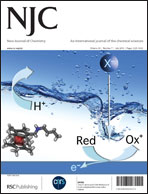Three 25,26-bridged para-tert-butyl-calix[4]arene phosphites, 1–3, have been synthesized by linking two proximal phenolic oxygen atoms of para-tert-butyl-calix[4]arene to a P(OR) [R = 2,6-But2–4-Me-C6H2 (1), 2,6-Pri2-C6H3 (2) or 2,4-But2-C6H3 (3)] moiety. NMR spectroscopic data and X-ray crystallographic studies (1 and 2 only) show that the calixarene framework in 1 adopts a cone conformation, whereas in 2 and 3 it assumes a partial cone conformation. Unsymmetrical 25,26;27,28-dibridged para-tert-butyl-calix[4]arene bisphosphites 5–7 have been synthesized by the reaction of 25,26-bridged para-tert-butyl-calix[4]arene phosphite 1 with (R′O)PCl2 [R′ = 2,4-But2-C6H3 (5), 2,6-Pri2-C6H3 (6) or (1R,2S,5R)-(−)menthyl (7)]. NMR investigations (homonuclear 31P COSY) revealed an unprecedented “through-space” phosphorus–phosphorus coupling of 223–244 Hz for these unsymmetrical 25,26;27,28-dibridged para-tert-butyl-calix[4]arene bisphosphites. The molecular structure of unsymmetrical 25,26;27,28-bridged bisphosphite 5 was determined by X-ray crystallography; the two phosphorus atoms are in close proximity and the P⋯P distance (3.543(2) Å) is less than the sum of their van der Walls radii.
![Graphical abstract: NMR and X-ray crystallographic studies of unsymmetrical 25,26;27,28-dibridged para-tert-butyl calix[4]arene bisphosphites with a large “through-space” P–P coupling](/en/Image/Get?imageInfo.ImageType=GA&imageInfo.ImageIdentifier.ManuscriptID=B903771C&imageInfo.ImageIdentifier.Year=2010)

 Please wait while we load your content...
Please wait while we load your content...